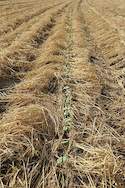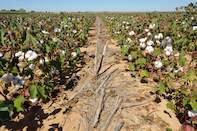
Cotton is a summer crop and requires adequate heat units to produce commercially viable yields. Cotton’s growth cycle is 160-180 days, depending on the cultivar, temperatures and plant date.
Flowering commences at 70 days, peaks at 90-105 days post planting, first boll burst on days 115-120, and fully opened between 130-160 days. Harvest till day 180. Development is dependent on temperature.
The most critical period of cotton production is the period directly after planting to ensure germination of the seed, a good plant population stand and fruit-set.
These are all depending on the planting date. Cotton’s growth and development are optimal when the average summer temperature is over 25°C for long periods.
Cotton can be grown under dryland conditions and under irrigation, but most small-scale farmers grow cotton without irrigation.
Cotton yields depend on various factors including climate, time of planting, input costs (e.g. chemicals, seeds, labour), water availability as well as weed, pest and crop management.
Under dryland conditions, small scale farmers can expect a yield of 400 - 800kg, while commercial farmers sometimes manage to get up to 2 - 3 tonnes/ha of seedcotton.
Under irrigation, the cotton yield is much higher and 4 - 6 tonnes/ha can be produced. These figures indicated the yield for ‘seed cotton’ - seed cotton is cotton before the cotton fibres (lint) are separated from the cottonseed.
Planting recommendations of the Agricultural Research Council (ARC), the Department of Agriculture, Forestry and Fisheries (DAFF) and Cotton SA vary, so new cotton farmers are advised to consult seed suppliers or technical advisors working in their area for the best advice. Cotton SA also provides smallholder farmer training for new cotton farmers.
Planting Cotton

When planting cotton, timing is important. When planting cotton under irrigation, soil temperature should be 16 to 18°C or higher for approximately 10 days. Too low soil temperatures mean slow germination and seedling diseases. This means the planting time is the second half of October to mid-November.
When planting cotton in areas such as the bushveld in Limpopo Province, the Lowveld in Mpumalanga as well as in KwaZulu-Natal where no irrigation is used (dryland cotton), soil moisture is important; about 20 - 35mm of rain before planting in no more than two precipitations is required, according to the planting recommendations of Cotton SA.
A soil pH of 5.5 to 7.5 is best and well-drained sandy loam soil is preferred. Cotton does not do well in sandy or clay soil or in conditions with high soil aluminium levels.
Cotton is planted to ensure a dense and uniform stand of seedlings. This is done by starting on a firm and fine seedbed and a high seeding rate (yet not under dryland conditions) The planting depth is 20mm (heavy soils) to 30mm (sandy soils). Irrigate after planting. Germination occurs after about a week.
Cotton farmers should sign a license agreement with the patent holder of their cotton seeds and, very important, plant a ‘refugia’. This area is planted with Delta 18 RF, a GM-cotton without the Bt-gene and therefore not resistant to bollworm attack. Planting the refugia with this cotton cultivar can prevent the development of bollworm resistance against the Bt-gene.
Pests and Diseases in Cotton
Until the introduction of genetically modified cotton (GM cotton), the main insect pests of cotton were various species of bollworm. Since the use of Bt cotton started in the mid-1990s, significantly fewer pesticides for the destruction of bollworm is used.
Bt cotton has genes obtained from a naturally occurring bacterium called Bacillus thuringiensis. Bt cotton produces a toxin that kills off larvae and most other caterpillar pests.
However, plant-sucking insects (e.g. thrips and aphids) may require greater management on Bt cotton compared to conventional cotton.
Weeds in cotton fields are dealt with by means of glyphosate sprays. Cotton has been genetically modified to be able to resist damage by weedkillers.
Avoid unregistered products and consult technical advisors on the correct use and timing of sprays to combat cotton pests and diseases. Weekly inspections of cotton fields will ensure early detection of any pests and diseases.
Please note:
New cotton farmers are advised to consult technical advisors of cotton seed suppliers or Cotton SA for help regarding the correct cotton cultivar, planting time, growth and spraying schedules. Information supplied above is not to be construed as agricultural advice.
By Marinda Louw